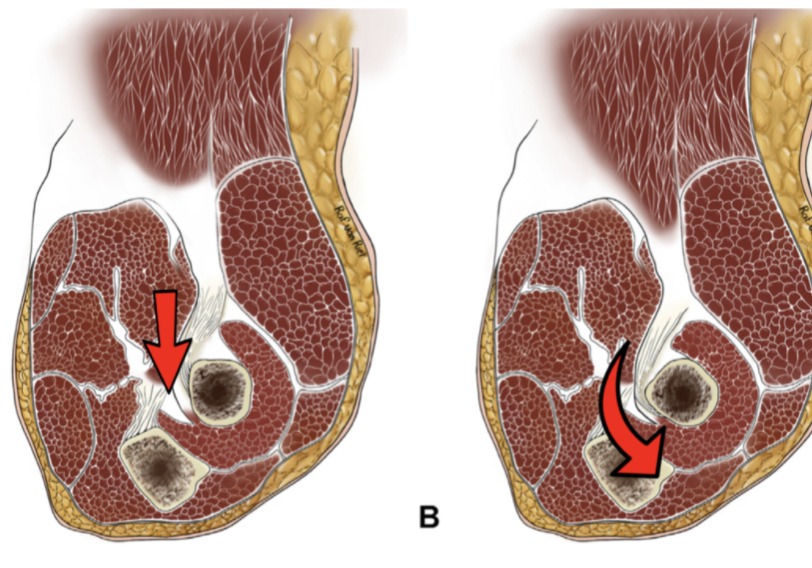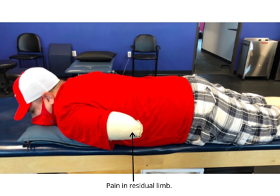Written by Melissa Miller
Introduction
Volkmann’s contracture is a rare condition that occurs after injury to the elbow and upper arm, typically from a crush injury. This condition can occur when acute compartment syndrome is left untreated. If unrecognized, Volkmann’s contracture can lead to a permanent deformity in the hand and forearm. Hand therapists are one of the providers who see patients in frequent and regular intervals after the onset of injuries. This makes them critical in the role of identifying and intervening if Volkmann’s contracture begins to develop. This post will discuss what Volkmann’s contracture is, the muscles that are affected, and what it may look like throughout its stages of severity.
Volkmann’s Contracture and Cause
Volkmann’s contracture is a permanent flexion deformity at the hand and wrist that has a claw-like presentation. Volkmann’s contracture is caused by acute arterial insufficiency to the arm. [2, 3] Most commonly, this arterial insufficiency is caused by compartment syndrome that occurs after an individual has experienced trauma to the arm (between shoulder and elbow) or at the elbow. Compartment syndrome is a condition where there is an increase of intra-facial compression in a closed compartment. [2, 3] Volkmann’s contracture develops from acute compartment syndrome if the compartment is not released, thus causing decreased blood flow and oxygen (arterial insufficiency) to the forearm as well as suppresses nerves within the compartment. When blood supply and oxygen are not able to supply muscles for an extended amount of time it has severe effects on those muscles. These effects include the shortening of the muscles and loss of function. With compartment syndrome causing arterial insufficiency and compression of nerves it results in muscle and nerve necrosis. [2, 3]. This necrosis then can transition into fibrosis within the muscle and calcification in the later stages. Compression of nerves can also lead to high ulnar and median nerve palsy.
Primary Muscles Involved
- Superficial Muscles of forearm: Pronator teres, flexor carpi radialis, palmaris longus, flexor carpi ulnaris, flexor digitorum superficialis
- Deep Muscles of the forearm: Flexor pollicis longus, pronator quadratus, flexor digitorum profundus
Contracture Severity, Presentation of Hand, and Treatment
Mild Contracture:
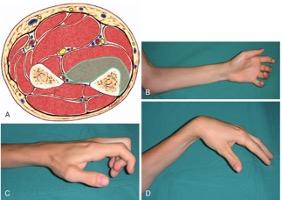
[4]
- Muscles: localized contracture, only involving parts of flexor digitorum profundus (cross-sectional diagram picture A)
- Clinical Presentation: flexion contracture in 2-3 fingers, typically including the long finger and ring finger (picture B, C, D)
- Sensory Effects: none – min sensory loss
- Therapeutic Volkmann’s contracture treatment: PROM stretching, progressive splinting, AROM exercises
Moderate Contracture:
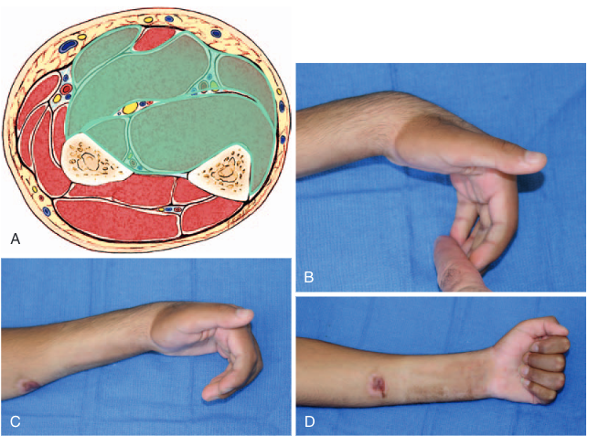
[4]
- Muscles: flexor digitorum profundus and flexor pollicis longus, may also include some of the superficial muscles such as flexor carpi radialis, flexor carpi ulnaris, and flexor digitorum superficialis (cross-sectional diagram picture A)
- Clinical Presentation: presents as claw hand with flexion at all digits and palmar wrist flexion (picture B, C, D)
- Sensory Effects: moderate sensory deficits in median n. and ulnar n. (more in median n.)
- No therapeutic treatment, requires surgery
Severe Contracture:
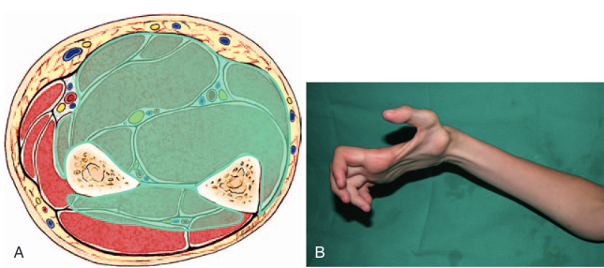
[4]
- Muscles: contractures in most extensor muscles and all flexor muscles of the forearm (cross-sectional diagram picture A)
- Clinical Presentation: severe contracture deformities, intrinsic muscle dysfunction (picture B)
- Sensory Effects: pronounced sensor deficits from median n. and ulnar n.
- No therapeutic treatment, requires surgery
Signs of Volkmann’s Contracture:
There are 5 signs that an individual will have with Volkmann’s contracture. These signs show throughout different severities of the condition; however, the earlier signs can help you identify as a clinician that the client’s symptoms may point to Volkmann’s contracture. The 5 signs have been referred to as the 5 Ps. [3] These include:
1. Pain
2. Pallor
3. Pulselessness
4. Paresthesia
5. Paralysis
Conclusion
Pain is the first sign in Volkmann’s contracture. A patient will start to feel pain with palpation over the affected area of the forearm. If you have a patient who is starting to have flexor stiffness in 2-3 digits and they have pain when palpating the arm, this may be a sign that the patient is beginning the early stages of Volkmann’s contracture. As the condition progresses the individual may show pallor where their skin looks bleached, as well as present as pulselessness, where you are unable to feel a pulse in the distal forearm. If the patient is in the moderate and severe stages, this is when they will show the signs of paresthesia, decreased sensation, and observable muscle paralysis.
Hand therapists are one of the few professionals who see individuals on a regular basis after injury. If compartment syndrome has gone unrecognized by physicians at early follow-ups, and mild Volkmann’s contracture begins to develop, a hand therapist may be the one most likely to catch it before it progresses into stages that require surgery. It is important that the clinician knows what Volkmann’s contracture is, as well as what the signs and symptoms are so they are able to catch it in time. If caught in the early stages, PROM, progressive splinting, and AROM exercises are key. If not addressed until later stages, then referral back to the surgeon may be necessary for surgical intervention.
Resources
[1] Clinic, B. (2018, May 25). Volkmann’s ischemic contracture flexor slide surgery. Retrieved November 24, 2020, from https://brahmanandclinic.blogspot.com/2018/05/volkmanns-ischemic-contracture-flexor.html
[2] Mirza TM, Shrestha AB. (2020) Volkmann Contracture. In: StatPearls [Internet]. Treasure Island (FL): StatPearls Publishing. Available from: https://www.ncbi.nlm.nih.gov/books/NBK557754/
[3] Physiopedia. (n.d.). Volkmann’s contracture. Retrieved November 10, 2020, from https://www.physio-pedia.com/Volkmann’s_Contracture
[4] Stevanovic, M. V., & Sharpe, F. (2017). Compartment Syndrome and Volkmann Ischemic Contracture. In S. W. Wolfe, R. N. Hotchkiss, W. C. Pederson, S. H. Kozin, & M. S. Cohen (Authors), Green’s operative hand surgery (pp. 1763-1787). Philadelphia, PA: Elsevier.
More To Read
Got Wounds? How to manage them as a Hand Therapist.
Wound care is messy. It can be intimidating and scary with so many variations of wounds (for example, white skin around wounds) and so many products out there, it is hard to know what to use, when to use it, and how to use it. If you go to a wound care conference, you’ll spend most of…
Read MoreNew Distal Bicep Tendinopathy Provocative Test for Hand Therapist
Caekebeke, P., Schenkels, E., Bell, S. N., & van Riet, R. (2021). Distal biceps provocation test. The Journal of Hand Surgery. The Skinny: These surgeons were looking for a provocative test for distal bicep tendinopathy (distal biceps tendonitis test), specifically partial tears, that was more sensitive and specific. Complete tears are more easily tested in…
Read MorePhantom Limb Pain, Residual Limb Pain, & Phantom Limb Sensation: Which is Which?
Written by Melissa Miller Introduction After amputation, the majority of individuals will experience phantom limb pain (PLP), residual limb pain (RLP), and/or phantom limb sensation (PLS). Experiencing these pains or sensations can greatly disrupt an individual’s quality of life. It is important to know what each of these are as each can impact the client…
Read MoreSign-up to Get Updates Straight to Your Inbox!
Sign up with us and we will send you regular blog posts on everything hand therapy, notices every time we upload new videos and tutorials, along with handout, protocols, and other useful information.



